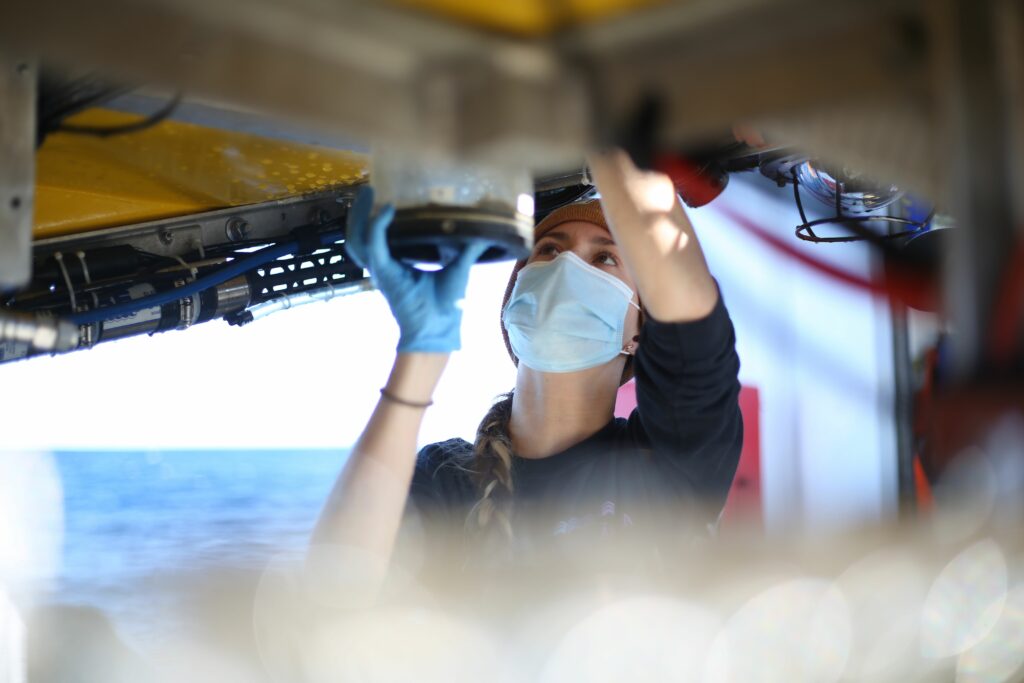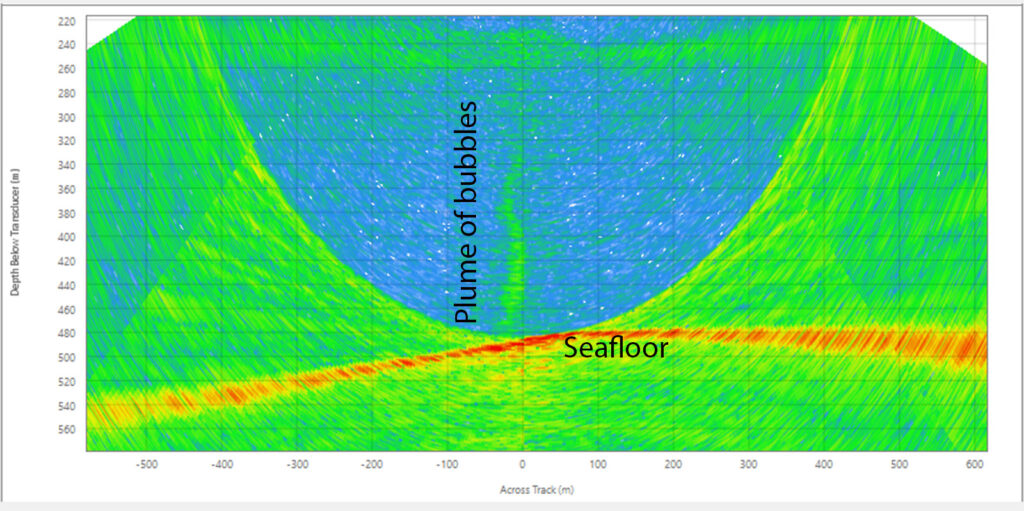By Lila Ardor Bellucci, Ph.D Student in Ocean, Earth and Atmospheric Sciences

Introduction
Methane seeps are places where methane gas escapes from reservoirs below the seafloor into the overlying waters. These seeps support unique and fascinating benthic communities that provide habitat and food to other deep-sea fauna, while also keeping methane from reaching the atmosphere. Because methane is a powerful greenhouse gas, scientists are interested in studying seeps to see what role they might play in climate change. Seep ecosystems may also be a source of energy, biopharmaceutical compounds, and valuable rare earth elements, all of which could contribute to the US “Blue Economy.” As we humans explore these potential resources, scientists like me are working to better understand seep communities and their functions to inform future management. This article is about two seeps my team and I encountered during an October 2020 expedition to find and characterize methane seeps along the Cascadia Margin – about 80 miles off the coasts of Oregon and Washington.

Ocean exploration
Part of the fun in exploring never-before-seen parts of the ocean is that it’s hard to predict what you’re going to find. Prior to entering graduate school, I participated in ocean exploration and research aboard the E/V Nautilus and R/V Neil Armstrong as a member of their Science Management and Marine Technician teams. This unpredictability was always one of my favorite parts of the job, and the same was true of my lab’s recent E/V Nautilus cruise to explore methane seeps along the Cascadia Margin. Even across similar ocean depths and latitudes, seep sites can vary dramatically in appearance and function, and in the animals and microbes that live there. One reason for this variation is that seeps can be thought of as having lifetimes and can look very different at different phases in their lives. During our recent cruise, we were lucky to find seeps at opposite ends of these phases, often called “successional stages.”
Searching for seeps
One of the first remotely operated vehicle (ROV) dives we had planned was to a site where past sonar data had indicated exciting wide-spread bubbling. The multibeam sonar is an acoustic tool, mounted to the ship’s hull, that allows researchers to map the seafloor and also detect methane seep bubble streams. As we came over the site, sitting about 1,000 meters (3,280 feet) below us, we were disappointed to find no trace of bubbles in our multibeam data. Would we descend and not be able to find the seep?

First seep
We decided to dive anyway, and the risk paid off. Shortly after reaching the seafloor, we were surprised to come across massive piles of carbonate rock, looming above ROV Hercules like dark towers. This type of rock is formed by the methane-eating reaction of bacteria and archaea (single-celled organisms, often found in extreme conditions) that live at seeps. Carbonate rocks of this size could have taken hundreds or even thousands of years to form! Similar to an old growth forest with large trees, the existence of these massive towers told us that the seep must be at a later successional stage in its life. Although we came across living clam beds, often found at methane seeps, this impressive site was no longer the bubbling frenzy it may once have been during its younger days.
Unexpected discovery
Our next discovery was even more unexpected. On our way to the late successional stage seep site, our multibeam mapping team noticed a large bubble plume in the sonar data, again about 1,000 meters (3,280 feet) deep. Although we hadn’t initially planned on it, we decided to take a chance and investigate further. As the ROVs (Hercules and its stabilizing companion Argus) descended, we picked up the acoustic signals of bubbling from over 100 meters (328 feet) off the seafloor, using an ROV-mounted sonar. When we arrived at the bottom, we were greeted by one of the largest microbial mats any of us had ever seen.
Second seep
As we navigated around its edge to gain our bearings, we realized that the mat of dense, white and gray bacteria seemed to go on forever, covering at least 50 square meters. As we explored its interior, we found numerous bubble plumes on the northern edge of the mat, filled with small tube worms and surrounded by extensive clam beds. This was a textbook young seep, in an early successional stage and (to our delight!) still soft and perfect for taking sediment core samples. At older sites, taking cores can be difficult because of those carbonate rocks that form, blocking the core tube as we try to push it in.
Collecting sediment cores
I should mention that, while the collection of sediment cores and other samples may seem like a simple task, each sample we collected was actually the collective achievement of a whole team. Our team was made up of the various specialists and scientists that ran each dive from within the “control van” aboard the ship, as well as those who joined us from land via satellite-enabled telepresence. While we (the science team and data loggers) dictated and recorded sampling, pilots manipulated ROVs and mechanical arms thousands of feet below them, navigators managed the position of the ship, and video engineers controlled the ROV cameras that we all used to see.
Processing samples
Each of the samples we collected on our dives was then processed as soon as the ROVs came back on deck. Because we ran 24/7 operations on the E/V Nautilus, both dives and sample processing could occur at any time of day. In the case of our “young” seep dive, processing our glorious cores and other samples took us over 7 hours. This was in addition to the 8 hours each of us spent on watch in the control van, in my case from 12 to 4 (both AM and PM). It was cold, it was muddy, and it was non-stop, but it was a whole lot of fun and all worth it. The samples we collected from these two diverse seeps, as well as the others we visited during our cruise, will now enable us to better understand these diverse seep habitats from various angles.
Conclusions
Although studying individual seep sites really well can be very valuable, it’s also important to study a broad range of seeps when trying to gain a better understanding of them. As this tale of two seeps shows, even nearby seeps can be very different, each telling us part of a larger deep-sea story. Unexpected discoveries like this help us to shape our understanding of a seep’s lifetime, thereby providing valuable guidance for future research.
Originally published on the NOAA Office of Exploration and Research website as a mission log for E/V Nautilus cruise NA-121: “Gradients of Blue Economic Seep Resources”.









